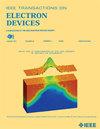A Circuital Model of Sb₂Se₃ Solar Cells as Memdiode Devices for Neuromorphic Applications
IF 2.9
2区 工程技术
Q2 ENGINEERING, ELECTRICAL & ELECTRONIC
引用次数: 0
Abstract
Memristors are one of the four fundamental electrical components, relating electrical quantities such as current, voltage, charge (integral of current), and flux (integral of voltage). First proposed in 1971 and experimentally demonstrated in 2009, memristors have garnered significant research interest due to their unique properties. Among their many applications, neuromorphic computing and memory storage stand out. However, memristive behavior is not limited to standalone devices; it can also manifest as a parasitic effect in various systems. Despite this, research on parasitic memristive effects remains limited, especially when compared to studies on resistors and capacitors. In this work, we present experimental evidence demonstrating that a Mo/MoSe2/Sb2Se3 (10 nm)/CdS (2 nm)/indium titanium oxide (ITO) substrate configuration, originally designed as a solar cell, exhibits memristive behavior. This behavior is investigated by applying both triangular waveforms and a series of voltage pulses to the solar cell contacts while recording the current transient response. Our proposed model builds upon the standard single-diode solar cell model, with modifications to incorporate the observed memristive effects as second-order, parasitic elements. The experimental data show that the proposed model fits well with the experimental results, confirming the memristive behavior in the system.求助全文
约1分钟内获得全文
求助全文
来源期刊

IEEE Transactions on Electron Devices
工程技术-工程:电子与电气
CiteScore
5.80
自引率
16.10%
发文量
937
审稿时长
3.8 months
期刊介绍:
IEEE Transactions on Electron Devices publishes original and significant contributions relating to the theory, modeling, design, performance and reliability of electron and ion integrated circuit devices and interconnects, involving insulators, metals, organic materials, micro-plasmas, semiconductors, quantum-effect structures, vacuum devices, and emerging materials with applications in bioelectronics, biomedical electronics, computation, communications, displays, microelectromechanics, imaging, micro-actuators, nanoelectronics, optoelectronics, photovoltaics, power ICs and micro-sensors. Tutorial and review papers on these subjects are also published and occasional special issues appear to present a collection of papers which treat particular areas in more depth and breadth.
 求助内容:
求助内容: 应助结果提醒方式:
应助结果提醒方式:


